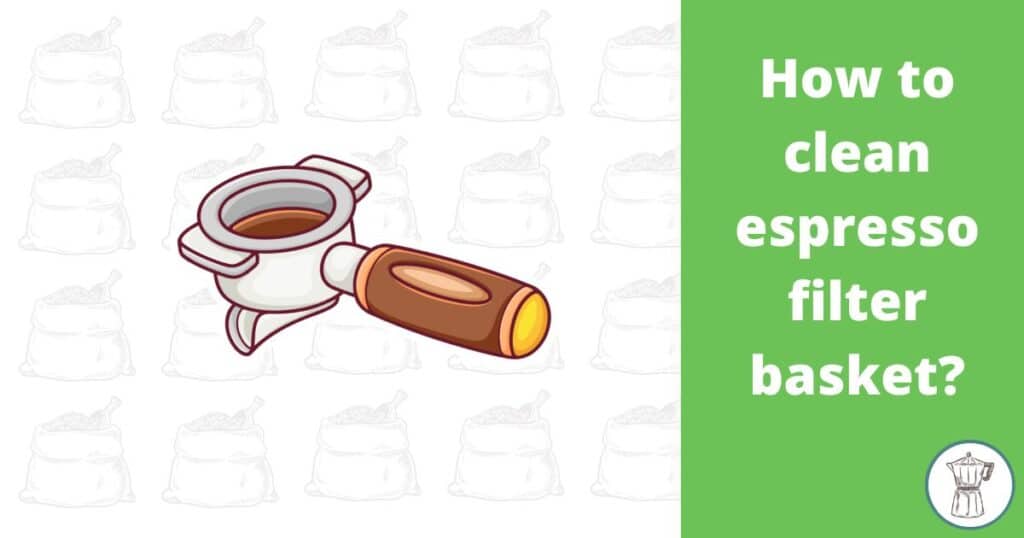How to clean an espresso filter basket?
It’s vital to clean your espresso filter basket to make sure your next brew doesn’t turn bitter. But where should you start? How often should you clean it? Stick around, in this article, we talk about how to clean your coffee basket the right way and make it look brand new.
Let’s kick off.
Key takeaways:
- What is a portafilter?
- What are the most common portafilter types?
- How to properly clean an espresso filter basket to make it brand new?
What is an espresso filter basket?
First things first, let’s have a look at what’s a coffee filter and how it works.
An espresso filter is typically made of metal and in essence, is where you put your coffee grinds and fit it in the portafilter and then the espresso machine. Heated water runs through the filter and (you guessed it) extracts the flavours and aroma of the coffee grounds and then it drips freshly made espresso.
It is vital to keep the filter clean.
How to clean an espresso filter basket?
Luckily, it’s easy to clean your espresso filter basket.
All you need to do is:
- Remove the portafilter from the espresso machine and take off the espresso filter
- You can use a coffee ground knock out box to throw the used coffee grinds away
- Rinse your espresso filter
- Use a kitchen roll or a dry cloth to wipe it and fit it back in the portafilter
- It’s critically important to get rid of the used coffee grounds right after you’re done with you’re brewing, otherwise, the next espresso you’re going to pull is going to be slightly bitter
Top tip: It’s no good to use washing-up liquid every time to wash the espresso filter; your espresso might taste the washing-up liquid. I use it only 3 times a week. This way you’ll also be able to get rid of the smell of your espresso machine.

What is a portafilter?
A portafilter known as ‘group’ is an indispensable part of an espresso machine.
It looks like a huge spoon that on its end fits the coffee filter, so the heated water can run through it and comes out as coffee. Its handle allows espresso machine users to lock the portafilter perfectly in the machine to brew and at the same time, it makes it easy to take it off the machine to give it a wash and keep it clean.
You’ll also find the spout on a portafilter (whether single or double). It helps espresso to come out of the machine and flow evenly into the cup.
If a portafilter doesn’t have a spout it’s called ‘naked’
Another integral part of a portafilter is the gauge whose job is simply to gauge the pressure of the pump, showing you that your espresso was made at the recommended pressure. (It’s more common for commercial use).
Coffee lover shares his view on espresso filter baskets:
If you’re pulling classic espresso blends and roasts at classic flow rates and ratios, you are probably better off ignoring “precision” baskets. A decade or two ago, many of the baskets shipped with machines and generally available were simply stamped. They could be dreadfully uneven across the bottom, to the point of impacting the flavor negatively. These days, most of the baskets out there are of reasonable uniformity, including those that ship with most of the major manufacturers of mid-range and up machines.
– Jeff
1. Pressurised portafilters
These are handy for beginner baristas.
They have a built-in mechanism that adds extra pressure to pull espressos the right way. Since this mechanism is in place, it means you shouldn’t rely too much on tamping and the grind size.
It’s built in a way to creates additional pressure on the basket holes.
2. Non-pressurised portafilters
As you might have guessed these portafilters are a better fit for experienced baristas.
When using such a portafilter it means that you have to make the ground size (what the espresso manufacturer recommends), tamp the coffee grounds to create extra pressure, and pull great espresso every time.
Why is this a better option for experienced baristas?
Because baristas can customise the coffee they want to make every time by tweaking the elements we mentioned above. In other words, it gives them more flexibility.
The table summarises the key features of pressurised and non-pressurised portafilters:
| Pressurised Portafilter: | Non-pressurised Portafilter: |
| Great for rookie baristas | Ideal for more experienced baristas |
| Built-in mechanism for extra pressure | More customisable in terms of coffee grounds |
| No much tamping needed | Proper tamping is needed |
How to clean your portafilter?
Here’s how to clean your portafilter easily:
Take it off the machine and remove the espresso filter
Use a cleaning solution in powder (preferably the one your machine manufacturer recommends) and mix it up with hot water in a container.
Place the portafilter in the container and give it 4-5 hours
Give it a good wash with washing-up liquid, let it dry, and put it back in the machine.
How often should you wash the portafilter?
There’s no hard and fast rule. It depends a lot on how many espressos you pull per day. If it’s too many, it’s wise to clean it at least once a week. But if you pull just no more than 1 espresso a day then you’ll be OK with cleaning it every other week. It’s vital to clean your portafilter thoroughly, so no burned coffee stays on it, otherwise your next espresso might taste like rubber.
Let’s wrap it up
It’s great to know how to clean not only your basket but every single bit of your coffee machine. I’ll state the obvious: the cleaner your espresso ground basket is the better espresso you’re going to have. I know you love coffee and you can’t really make compromises, on coffee. Go ahead and read our guide on how to clean Philips espresso machine.

- How to Remove Coffee Stains From Countertop The Easy Way - December 21, 2023
- Can You Reuse Coffee Grounds in French Press? Truth Inside - December 12, 2023
- Can Expired Coffee Creamer Make You Sick? 3 Ways to Find Out - December 9, 2023
